| |
Looking for Wright Flyer Plans
From: Graham Taylor an.taylor@bigpond.com
Do you know anybody that would have set of drawings for the Wright flyer glow or
electric? Also looking for Gee Bee racers.
(If anyone could help Graham, it would be much appreciated. KM)
Return to "What's In This Issue?"
Centennial of Flight 2003- Australian Aeromodellers Tribute
From: John Bird birdy@optushome.com.au
Ken,
I am a long-time recipient of your newsletter grateful user of your site and resources.
THANKS.
I am a member of the Australian Electric Flight Association, two other R/C flying
clubs and the Aerobotics UAV R&D team at Monash University - Melbourne Australia.
Amongst other 'retirement' pastimes I am also co-author of a website on Aviation
History which currently attracts over 5 million hits per year.
A recent addition to the site deals with the history and evolution of aeromodelling
and the "Centennial of Flight 2003- Australian Aeromodellers Tribute".
Whilst a focus of the Tribute is upon Australia, aeromodellers world-wide enjoy a
shared history and are encouraged to participate and celebrate the role aeromodelling played in the history of Aviation. NB. We
already have Aeromodellers in the UK participating.
As a US citizen you may be interested in the on-site documentation of Reginald
Denny which has been undertaken with assistance from his children. www.ctie.monash.edu.au/hargrave
For our 2003 Tribute events we have concentrated upon the building and flying of
two or three Australian "Classics". Models which were design over 50 years ago in the transition period between
FreeFlight and Radio Remote Control. Models which have reputation as being easy to build and FLY.
Models which are also relatively easy to modify to suit contemporary materials and
equipment and can be adapted to suit individual build and fly preferences eg. R/C , Electric, ParkFly, Indoor.
Poster/Plans for these 2003 Tribute Classics are available for down-loading from
the site (ref: set of URLs below).
Kind regards and thanks again for your site,
John
URLS from John
www.ctie.monash.edu.au/hargrave/tribute.html (home)
www.ctie.monash.edu.au/hargrave/tribute_04.html (download POSTER/PLAN).
www.ctie.monash.edu.au/hargrave/tribute_01.html (model makers of the past).
www.ctie.monash.edu.au/hargrave/tribute_02.html ( history of remote control).
www.ctie.monash.edu.au/hargrave/tribute_03.html (aeromodellers gallery).
Return to "What's In This Issue?"
Electric Flight Yahoo Groups Forum
From: Ron Fikes srfikes@earthlink.net
I have originated a site on Yahoo Groups (see below) to share information and tips,
etc. on electric flight "stuff" and activities for the Rancho San Antonio Electric Flyers. Many of Email providers
have blocked the group messages that I send, as SPAM, even though it is not.
Please check the privacy policy (below) before signing up.
Ron Fikes
YAHOO PRIVACY POLICY
Registration Data and certain other information about you is subject to our Privacy
Policy. For more information, see our full privacy policy at http://privacy.yahoo.com, or
if you came from Yahooligans!, then see our Yahooligans! privacy policy at
www.yahooligans.com/docs/privacy.
Here are the addresses for the website, posting messages, subscribing and
unsubscribing. http://groups.yahoo.com/group/RSAelectricflyers
Post message: RSAelectricflyers@yahoogroups.com
Subscribe: RSAelectricflyers-subscribe@yahoogroups.com
Unsubscribe: RSAelectricflyers-unsubscribe@yahoogroups.com
List owner: RSAelectricflyers-owner@yahoogroups.com
Return to "What's In This Issue?"
Kyosho Trainer 40 and Multiplex Skycat
From: Chispas chispas@sapo.pt
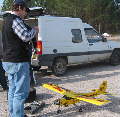
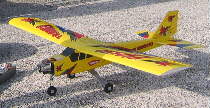
Dear Ken,
I would like to have your energy.
Did you remember my Kyosho Trainer 40 with two motors and 16 cells? Well, after
various fast and hairy flights and long running on the ground during landing, it arrived very fast, I came to the conclusion that the
Trainer was not. It was too heavy at 121 plus oz., more than two pounds heavier than the IC version, and with an very high stall
speed. After comparisons with my Flash, now defunt (RIP), I changed the two motors for a Kyosho Atomic Force, geared to 4:1,
12x10 APCe prop on 8 3000HV cells. It develops 6200 Rpm plus on, theoretical, 38 Amps. Now it is an Trainer with weight,
speed and duration to match. AUW is 95.5 oz. and power is 50W/lb. Success! I used standard servos
and receiver in order to prove a cheap and straight conversion of an IC ARF.
In the meantime I built (assembled) the Multiplex Skycat with a similar setup:
Kyosho Atomic Force, geared to 3.45:1, 11x8 CAM prop on 8 3000HV. It develops 7900 Rpm plus on, theoretical, 34 Amps. It
flies very well, fast and slow, and I am regaining my confidence on a very aerobatic plane.
As you can see in the photos, the gearbox on the Trainer is my own, now with only
one motor. I can change for one lighter gearbox, but this one permits me to swap gear ratios from 2.96:1 to 8:1, depending of the
pinions available.
The gearbox on the SkyCat is the old Kyosho one, but the GD600 from Great
Planes could be used too, or the Jamara 2.9:1 that uses the same pinion as the Kyosho, 11-tooth in the case of 3.45:1 gear ratio,
they are an direct swap.
The motor used belongs to the Kyosho Mad Science series, 17 turn with an plastic
fan on the winding, but this one is called Aqua Speed Marine as the endbell is carved in aluminum and it permits the use of more
current without overheating. The flights end with the motor barely warm.
The propeller of the SkyCat is an Graupner CAM 11x8, very disappointing on bench
tests, I was expecting some more RPM, but this propeller unloads very well in flight and against an APCe it showed more trust
and speed available, I donít know why as the APCe seems to be lighter and better.
The SkyCat has an AUW of 53.5 Oz., right on the sepcs of Multiplex, and with 34
Amps on 8 cells it has 81W/Lb. I can change to 10 cells, but I only use 7 and 8 cells on my other planes and the motor doesnít
seem to like to be used on 10 cells on bench tests. I donít think that my skills will handle such an performance, even now I am
struggling to match my capability to doing wild things, some call it aerobatics.
There is a photo of me and the Kyosho Trainer at a recent meeting: "First
National Meeting of Electrics" where only electric airplanes are allowed. It was held on November, 10, at the club
"Asas de Mira", (wings of Mira), at the city of Mira, an city by the sea on the Centre region of our little and sunshine
country. It was very friendly, with a very good meal by the club associates, and full of various kind of electric planes, going from
sailplanes to park flyers and from aerobatics to multi engined planes.
It was good to see old friends and some news and to know how our hobby is
evolving on our country. A very good day. Hoping for the next one.
Keep up with the good work and thanks for the newsletter.
Happy landings.
Paulo "Chispas" Faustino
Portugal
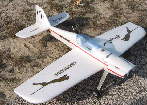 Return to "What's In This Issue?"
Return to "What's In This Issue?"
Bernardís New Plane
From: Bernard Cawley bernard.e.cawley@boeing.com
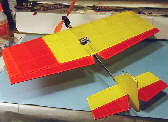
Ken,
I've another new plane! Todd Long has done it again. This one is called
"Tiny-X" and I now can say I can do cul-de-sac aerobatics - and with a GWS/EDF hybrid drive and Kokam Li-Polys
I can do it for 25 minutes continuously if I want to. Insides, outsides, inverted, rolls like crazy, and any combo of those you can
string together without a rudder. All up weight - 6.3 to 7.0 ounces depending on battery choice.
The picture was taken before flying. It still looks like this except that it now has an
"E" ratio gearbox with it's big ring gear on it with the 4.8V/EDF motor in it.
(Bernard and I exchanged some comments on receivers. The FMA M5
and MPI receiver were a part of our conversation. As I noted last month, I received my FMA Extreme 5 and it weighs
0.4 oz. on my digital scale. That is the advertised weight. Itís a great little receiver that worked excellently in the
crowded RF environment of the Oakland Yard dome. Bernard suggest that I weigh my M5 with crystal installed and see
the difference between that an the Extreme 5. Iíd talked about using the M5 in my "Cheap Thrills", but
opted for the Extreme 5. If anyone with digital scales could send me the results of weighing the M5 with crystal
installed, Iíd be grateful. KM)
I agree with you on the Maxx Products receiver - I've never been able to make
one work at all - even in front of my house. (Mine works fine when flying solo. KM) So, planes I fly at club fields I
either fly carefully with the GWS receivers (and have only had one "incident" that was bad enough to bend an airplane) or use
Berg or FMA.
(For those who care, Iím sticking with Hitec and FMA from now on. I
donít fly really small planes, so weight is not a total issue. With the Extreme 5 weighing in at an honest 0.4 oz., itís good
enough for me. KM)
Return to "What's In This Issue?"
Amptique Update
From: Robert Comerford flyelectric@dodo.com.au
Hi Ken,
Just a note to clarify my last email. My Amptique is years old. It is actually the
second one I have owned. This one built from the plans to replace the original. The first was given to a dying friend and maybe is
still with one of his children. I imported the original [to Australia]when they were unavailable here, and I may well have had the
first in the country. I was looking for a trainer that would fly for longer than the Le Crate I was using to teach beginners but
would still ROG. I may have been influenced by Keith Shaw's rap for it in a magazine article. Thank Keith for me. It fulfilled
all it promised.
I emailed Lyndon Percy direct re his ROG aerobatic plane. Hope my suggestions help him.
regards
Bob
P.S. Maybe receivers are cheaper your way Ken. Here I prefer the protection of a good thick layer of foam or even a
Styrofoam box lest the ground come up and smite it. hihi.
(The P.S. Comment was in regard to my comment to Bob that I only Velcro
my receivers in. KM)
Return to "What's In This Issue?"
Ben Howard's "IKE" 1/4 Scale Project
From Dave Grife grifesd@yahoo.com
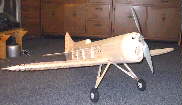
(I received an email from Dave Grife pointing to information on his latest
project at the R/C Groups Discussion ( www.rcgroups.com/forums ). It can be reached through the Ezonemag at
www.ezonemag.com Photos are by Dave. KM)
The latest project of mine is a work in progress.
The 1/4 scale model:
64" span
700 sq. inches
airframe weight 46 oz.
finished estimates:
112 oz.
wingloading- 23 oz./sq.ft
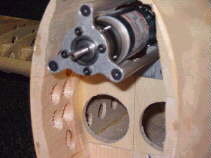
Here's a picture of the MaxCim motor w/ planetary gearbox. The MaxCim
MaxN32-13Y on 20 cells turns a APC electric 18-10 at the same RPM as a Hacker B50 XL on 20 cells.... and the MaxCim is
much smoother on the throttle.
I'm also using the new "Super Universal Mounting" System motor
mounts available from New Creations. This is by far the best commercially available mount that I've ever used. The S.U.M.
mount is very light weight and much more rigid than anything that I could make. The cool thing about it is that you can mount
virtually any motor on it with the various frontplates and the length is adjustable for various motor/gearbox/shaftlengths.
This is ideal for me, because I love trying different power system setups in planes.
I'll be putting the wheel pants on next week.
The Howard's "IKE" was all gloss white with black lettering.
Mr. Mulligan was another one of Ben Howard's later designs again all white with
black lettering.
The "IKE" raced in the National Air Races beginning in 1932 through to 1938,
winning many of the events throughout it's racing career.
The model will weigh about 7 pounds. I'm planning on running at 900 watts to the
motor using 20 cells.
Scale full speed was 240 mph. 60 mph (1/4 full scale speed)--- easily obtained.
Return to "What's In This Issue?"
Our Eyes Were Opened
From Jeff Sayre sayre@cass.net
Ken,
My son Adam (13) expressed an interest in R/C planes last winter so we got him an
Intruder by Air Hogs for Christmas. We were very disappointed.
A friend who flies gas R/C suggested we go to the Ann Arbor Golf dome and
check out some electrics. It was very interesting. There were everything form slow fliers to heloís.
An older gentleman saw we were interested in flying and gave us a Telemaster
(gas), radio and all the equipment needed to fly it!
What we really liked at the dome were the Zagis. We bought two at the Toledo
Show. Adam is a much better pilot than I am (Nintendo - PS2, ect.) and loves to power down his 400X and glide.
We would like to use the 2 geared motors out of the Intruder and make some
other sort of plane. Do you have any suggestions for two beginners?
Thank you,
Jeff and Adam Sayre
Petersburg, MI
(Anyone have any ideas for the little motors from the Intruder? KM)
Return to "What's In This Issue?"
Typical Comment and Question
By Ken Myers
(I am a volunteer at allexperts.com. I answer questions about both glow
and electric R/C planes. I receive three to five questions a week, and about 95% are questions and or comments about
electrically powered R/C planes. The following is the exact comment and question that I received and answered on
December 12, 2002. I have only removed any reference that would allow the individual to be identified in any way, as
IĎm sure they had no idea that their letter would appear in print here. KM)
Hello
I have wanted an RC plane since I was a kid. The wonderful thing about parenthood
is that as a father I can fulfill some of those dreams.
I recently purchased an RC plane called an "Airhog" after reading how
tough and inexpensive the thing was. The thing was so underpowered that I couldn't keep it in the air for more than 20-30
seconds even though I was flying it on a still day in an open park. It ended up going back to ToysRUs.
I am looking at the following criteria:
1. Total cost of <$125 - to keep the wife from freaking out, though I do have the nagging/whining capabilities of a 6 year old
at my disposal.
2. Something that I can fly in a suburban park. This limits me to electric, right? (Gas powered would also break the bank).
The nearest RC club is about 20 miles away and so I need something that isn't loud or could be conceived as a "safety
threat" by paranoid suburbanites.
3. Relatively durable. I realize that airplanes crash and there is a tradeoff between weight and durability. To give you some
idea, I flew the airhog for two hours with the occasional crash but was able to return it after touching it up with a permanent
marker and yellow highlighter.
So I'm not too worried about this.
I'm currently thinking about this plane: Firebird XL
www.firebirdxl.com/hbz2000-compare.htm
According to the site it stays up for 15 minutes and can climb quickly without
stalling.
So what do you think?
(My response was that I hoped that his experience with the "toy"
plane did not sour him on the R/C flight experience. I did not respond specifically about the claims made by the
marketers of the Firebird XL. I concluded with the full text of the "Getting Started In Electrically Powered R/C"
from the January 2003 Ampeer. KM)
Return to "What's In This Issue?"
Upcoming Indoor Fly in Cedar Falls, Iowa
From: Bobs R/C bobsrc@forbin.net
Greetings indoor flyers,
The BlackHawk R/C Pilots are having a two day indoor contest in the University Of
Northern Iowa UNI-Dome, which is an indoor football stadium seating about 17,000 people. This event will be the 1st & 2nd
of March, 2003. Saturday the 1st from 6 - 11 PM and Sunday the 2nd from 7 AM to 4 PM. We fly R/C and free flight and will
be having regular contest events along with open fun flying.
The R/C events are sponsored by Sig Mfg. Co. and include Indoor R/C Sport
Scale, Indoor R/C Fun Scale, and Indoor R/C Duration( AMA #627). Free flight events include #212 HL Glider, #215 Bostonian,
#219 Unlimited Catapult Glider, #221 Electric Duration, #505 Peanut Scale, FAC No-Cal scale, and one design duration based on
the AMA Cub- Jr. & Open classes.
A snail mail address will get a copy of the rules and information on the area in the
mail. You can view some pictures of our Dec. 1st fly in at kimhome.tripod.com/main.htm.
Click on the UNI-Dome Indoor link.
Cheers,
Bob Nelson C.D.
Bob's R/C Hobby Store
6322 University Ave.
Cedar Falls, IA 50613
319-277-0211
Return to "What's In This Issue?"
Lightweight, Inexpensive Digital Cameras
From: David Summers ironsidz@look.ca
Ken:
I don't know if you have been following the developments in very lightweight,
inexpensive digital cameras, but there is the discussion going on in:
www.rcgroups.com/forums/forumdisplay.php?s=55e52748a3325cec9b23fc9cde37f59c&forumid=128
that shows interesting developments using light electrics to lift the inexpensive
CMOS chipped Aiptek and Mustek digital cameras that are in the 6 ounce range. With photos from 1.3 to 2.1 megapixels, the
output is quite acceptable. I have yet to get my hands on either model. CMOS cameras do not tolerate vibration. However with
electrics, the motor is switched off, the photo taken and power restored. That might even get me back into the e-fold!
The Push-E Cat would appear to be a good lifter for these cameras.
David Summers
Port Perry Float Flyers
(Thanks for the information on the cameras and the positive comments
about my January editorial on getting started. KM)
Return to "What's In This Issue?"
Barry Wilsonís S400G Design
From: Barry Wilson Jbarry.Wilson@btinternet.com
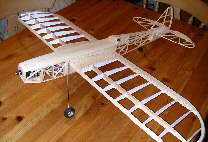
Hi Ken,
Itís deep in the Winter Gloom here in England. Flying has been curtailed now for
some time. I have just caught up with the events and information in the December Newsletter. Keep up the good work. We
donít seem to have a similar site over here.
(I sure hope youĎve checked out the British Electric Flight Association at
http://www.befa.org.uk. Lots of good info and the Electric Flight U.K.
newsletter. KM)
I have kept myself busy designing and building. My latest project is a mid-wing
sport model using a geared S400 motor. The wingspan is 36 inches with a chord of 8 inches. All-up weight is coming out at 16
oz. This model is the result of a "doodle" when talking to some of our young Club Members.
One of the photos shows it "naked", but it is now clothed in blue `light-film` on the
flying surfaces and red on the fuselage.
Hopefully Spring will bring some flying weather!!
There is a photo of a model that I sent a photo of some months ago (Parasol wing,
Slow-flyer), during a late Summer flying session.
Regards,
Barry Wilson
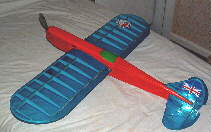 Return to "What's In This Issue?"
Return to "What's In This Issue?"
Electric Control Line
From: robert comerford flyelectric@dodo.com.au

Ken,
I have attached photos of my old parkliner mark 1. It was part of an experiment
into e-CL some time back. The plane is an OD made from balsa, ply body and clear document covering. About 1300 sq.dm
(176 sq.in.), weighs about 380 gm (13 oz.). It has a S400 6V with Gunther prop in the photo. It has flown with other props and
another (7.2V) motor. Fuel tank is an 8 by 500AR pack (from my radio planes) held in outboard wing with rubber bands. Very
rough but worked. Control is by a relay circuit powered from battery pack and turned on and off from control handle using a
microswitch. Lines are plastic covered steel lines 10m (30') sold as fishing trace. Large wheel should tell you something about
the size of the divots in the CL circle at our club due to horses. Plane will wing over and loop. I think this sort of thing would be
nice indoors with a scale model where you did not want radio but still wanted to see your creation fly. I did some other
experiments and may be able to provide more info later on.
Return to "What's In This Issue?"
Guyís Favorite R/C Aircraft
From: Guy Marshall guy.marshall@gm.com
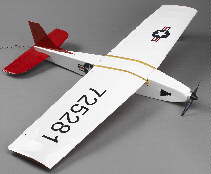
Ken,
Let me tell you about my favorite R/C airplane. Itís the Bill Griggs Models
ASSAULT. This is a speed 400 shoulder-wing sport plane. Flying the plane is a joy. It has a very wide speed range. It is
happy going fast and can also slow way down. The plane is rock solid in high speed flight. Rolls are axial. The plane will also
fly slowly quite well. Duration is 3 to 4 minutes with no throttle management using a 6.0v speed 400. Duration is a few minutes
longer with throttle management.
The wing area is 201 sq. in. Ready to fly weight is 15.4 ounces when using a
seven cell pack of Sanyo 600AEs. I covered the plane with Monokote and used two Hitec HS-55 servos with a FMA Direct
Extreme 5 Sub Micro receiver.
I had built two planes prior to building this kit. I struggled with the building due to
my own inexperience. However, I received plenty of help from my club members at the Ann Arbor Falcons.
During my first month of flying this plane, I had one issue with it; the 3 - 4 minute
flight duration was too short and I had a desire to fly faster. Tom Hunt of Model Air-tech
(www.modelairtech.com) came to my rescue. For $140.00 Tom sold me a
MEGA 16/15/4 brushless motor and a JETI 18-3P brushless speed controller. I have been happy ever since. The plane rips
through the sky. The plane is simple to launch.
I have tried several different battery packs. My favorite is a Zagi 400x pack -
eight cell KR-1700AU pack. Flights are always over ten minutes even at full speed.
The attached photograph was taken after the plane had flown over 200 flights.
Guy Marshall
Ann Arbor, MI USA
Ann Arbor Falcons
gsmarsha@aol.com
Return to "What's In This Issue?"
Figuring Wing Area
From: AlanWhitworth alan@e-flyer.fsnet.co.uk
Hi Ken,
In the November Ampeer you showed a way to calculate wing area.
Another simple way, with a straight tapered wing, is to measure the root chord, add this to the tip chord and multiply the total by
half the wingspan. It works with sweepback and sweepforward as well.
Using your drawing it works out as follows:-
root chord: 8.5 inches
tip chord: 6 inches
half span: 30 inches
( 8.5 + 6 ) x 30 = 14.5 x 30 = 435 sq. inches.
BTW - your calculation is wrong. It's all explained in your explanation. :-)
Thank you for an excellent read every month.
Cheers,
Alan Whitworth,
Sheffield, UK.
Return to "What's In This Issue?"
Glow Power/E Power Relationship
From: John Lewis hjohnlewis@hotmail.com
Hi Ken,
I know that you are extremely busy, but I wondered if you could help me.
Because of you, I have entered this Electric airplane R/C hobby. Unfortunately
because of my success, my local R/C club has asked me to give them a short talk, on electric planes at our next meeting on
January 2nd 2003.
I have no problem with the basics (As I will unabashedly plagiarize from Ken
Myers et all!). Where I need help is the fact that I have never touched a gas engine and have no idea of equivalents.
Taking your advice on what to do after the first LT 25, I built a new one, with a
MaxCim N32-13Y, the MaxCim controller a 3.75:1 gear driving an APC thin electric 16 by 10 prop with 20 cells. This gave me
approximately 40 Amps at 18 Volts for some 700+ Watts. I have used this identical power system in a Sig 4 Star 40 with a
weight of 90 oz that definitely caught the eye of my gas flying friends.
My next project was a Sig Somthin' Extra using a Hacker B50 11XL 5.2:1
planetary gear box the hacker controller the new APC 18 by 12 thin electric prop with 20 2400SCRC zapped cells from Mr.
Weaver. Using a UBEC to eliminate the RX battery, the plane weighs 116 oz. and develops 44 amps and some 900+ Watts. This
has vertical performance and definitely caught the eye of the club President etc.
Because of these projects, I have been asked to talk about Electric planes, as they
have seen nothing like this before. BUT my question is, What would these equate to in glow/gas engines? You are the only
person, who I could think of, who understands both worlds.
Just a quick short e mail would be most helpful.
With many thanks for having got me into this problem!!!
With all best regards,
John
(My basic reply to John was that there are no direct equivalents. Motors
are not the most relevant way to compare glow and electric power. A given electric motor, like the MaxCim, has a very
broad useful power range. When comparing, and donít do it, glow to electric the number of cells [rpm - voltage] and
prop size [load - amp draw] are more relative, but most glow fliersí eyes will just glaze over when you talk to them in
that language. Just ask them what they want to do and what kind/size airframe they will be using. Tell them what they
need and where to find more resources if they are really interested. Also, it has been my experience that most glow
powered R/C pilots are "happy" with a Zagi for tearing it up at the field or a slow/park flier for flying
closer to home. KM)
Return to "What's In This Issue?"
ASPIRE EP
From: Larry Bailey lnbailey@cox.net
Using the stock "can" motor, stock folding prop, 7 x 800 mAh cells, I
would rate it a zero (0). The aircraft would not climb.
With a Speed 500/2.8:1 gearbox, 7 cells, 12x7 aero-naut prop, I rate it a three (***).
Using this power system I placed fourth out of eight in the all up/last down at Blakesburg, IA 2001 EISS meet.) It has a good
climb, of about 250 ft./min.
With the Speed 600BB/3.8:1, 8x1900 mAh SCR cells and aero-naut 12x8 folding
prop, Iíd rate it a four (****). Iíve had three flights to date, with a very good climb rate of about 500 ft./min.
Flight observations: The glide, airspeed and sink rate with the Speed
500 and 600 equipment is very nearly the same. Due to the low sink rate, landings require a long flat approach. Spoilers or flaps
would improve landing.
The transaction from glide to power with the S500 was smooth. With the S600 the
nose pulls up somewhat, (6 degrees D.T. in both motors) requires one to be ready to hold a small amount of down elevator until a
good climb rate is established.
Conclusion: The ASPIRE EP with the S600 power is a nice aircraft to
get in stick time for glider flying and landing approaches. Light lift gives 15 to 35 minute flights. The best time has been 56
minutes during good lift. (I lost my nerve and spiraled down).
(Thanks for the info and the ratings. It has been a LONG, LONG time
since IĎve gotten any ratings to add to the ratings page on the EFO site. KM
http://members.aol.com/kmyersefo/page38.htm )
Return to "What's In This Issue?"
Getting Started
From: Robert Comerford flyelectric@dodo.com.au
Ken, don't apologise. It needed saying. I would like you to consider one other point.
It is the need for forward planning.
It has been my long held belief that those starting out in this hobby should have a
power system that will serve them well for many years of development. The power system should be capable of providing them
with long training flights in indifferent weather conditions with standard radio gear and a reserve of power for less than desirable
quality of assembly. It should then be capable of powering their intermediate and aerobatic models for adequate flight times
without the need to shed undercarriage. A glow .40 does all this!
Electric planes, are to me, defined by battery pack. My favourite is the 10 cell
plane. For me the biggest investment is in my battery packs, and I want to use them to the utmost. When I go flying I take 2 or 3
planes and generally all these planes fly on the same battery packs.
Currently I fly trainer, intermediate sport and pattern type aircraft on my current
10 cell packs of 1250SCRP. My flying field is 40 miles away and I am usually there for 4-5 hours. In the future I will be using
these same packs (or their replacements) to fly control line and aerobatic gliders and anything else that grabs my fancy. Sure, I
have one or two special purpose models powered by other battery systems. These are for flying away from designated model
flying areas (such as in parks) and are just sidelines to the main game.
It is not necessary to have the latest motor or cells to achieve all this. I have been
doing it for years on geared buggy type motors and NiCads. If you have access to the latest brushless motors and lithium polymer
cells you can do it even better. I actually consider the development of better batteries as reducing my need for more efficient
motors.
I have said many times before there are plenty of good 10 cell planes out in the
marketplace. They are just misrepresented as suitable for 6 to 7 cells. I am also not pedantic about using ten cells. Anything from
9 to 12 in a pack would work. Anything less needs too much current to develop the needed power and any more and you start
emptying your field power source at an alarming rate. There is now a new advantage for 10 cells - the series 3 cell li-po is being
used as a direct replacement pack.
Another consideration is the shape of our packs. I have used the folded pack in
most of my planes since my 7 cell days. If the manufacturers and designers can agree on a pack shape I will gladly change all
my planes to suit.
You will notice I have not emphasised motors. I select motor type, number, gearing
and prop to deliver the required power output on a 10 cell pack. No rocket science is required - just an ammeter! I can use
anything from series S400's to an S700.
I am attaching a picture to emphasise my point. All fly on the same packs in
weather that I can stand up in.
Regards,
Bob
P.S. You have probably experienced this yourself many times Ken. The expectant look, the six cell buggy pack and
re-badged mabuchi in one hand, the soggy old .40 plane in the other - and the question. What prop do I use to fly this please ??
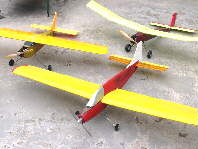
(Thanks for your very thoughtful input. I couldnĎt agree more. As a
matter of fact, weĎve reached pretty much the same conclusions while separated by half a world! Can two people who
agree in a world of millions be wrong? ;-) KM)
Return to "What's In This Issue?"
www.profili2.com
From: Stefano Duranti st.duranti@tin.it
This message to inform that the new official site of Profili has born today:
www.profili2.com
and mirrored at:
digilander.libero.it/profili2
utenti.lycos.it/profiliv2
members.lycos.co.uk/profili2
The web site you published in Ampeer is no more active.
All the best
Stefano Duranti
via della Casazza 43/b,32032 - Foen di Feltre (BL)
Tel. 0439310326
Return to "What's In This Issue?"

Bantams at the Oakland Yard. Left: Ken Myers's - Right: Don Belfort's
Return to "What's In This Issue?"
To Reach Ken Myers, you can land mail to the address at the top of the page. My E-mail
address is:
KMyersEFO@aol.com
EFO WEBsite: http://members.aol.com/KMyersEFO/
|
|













